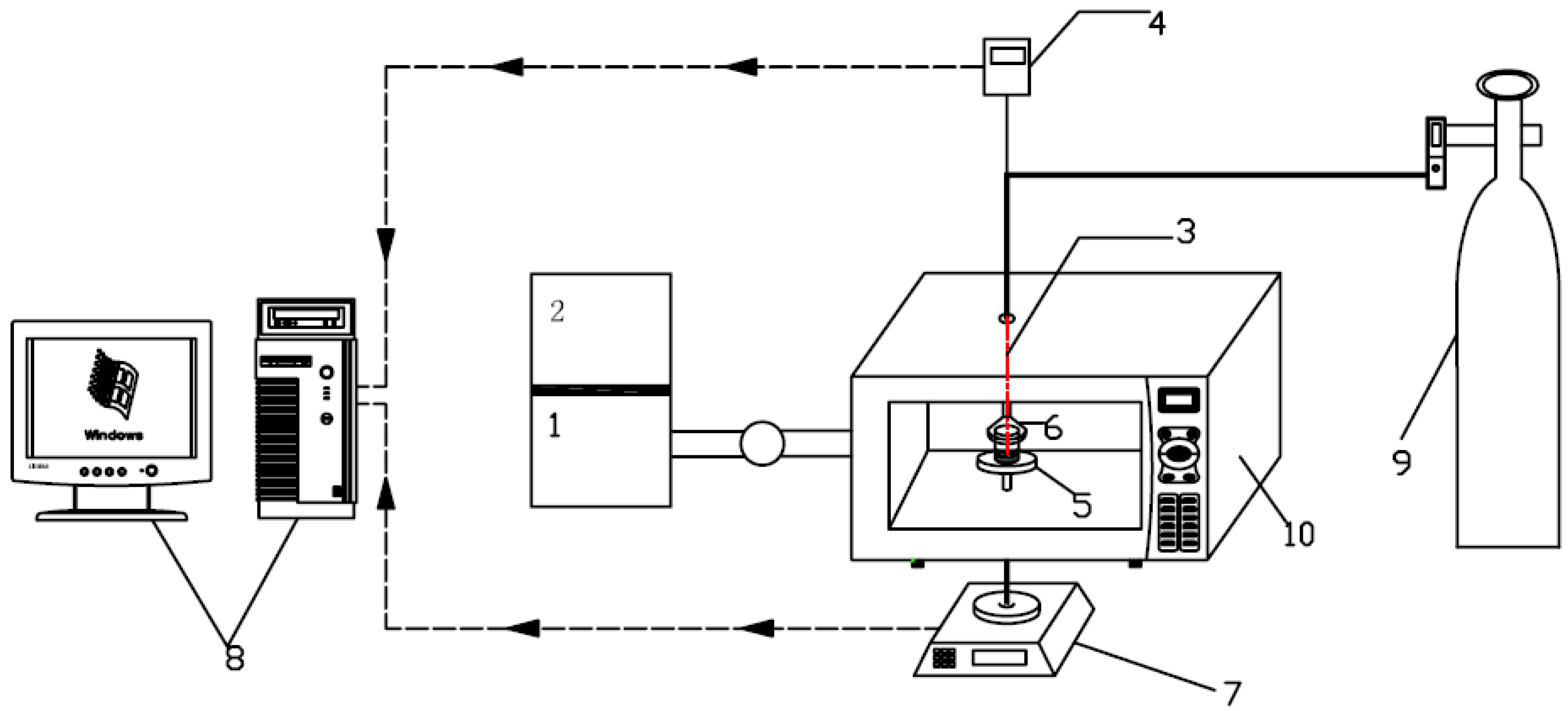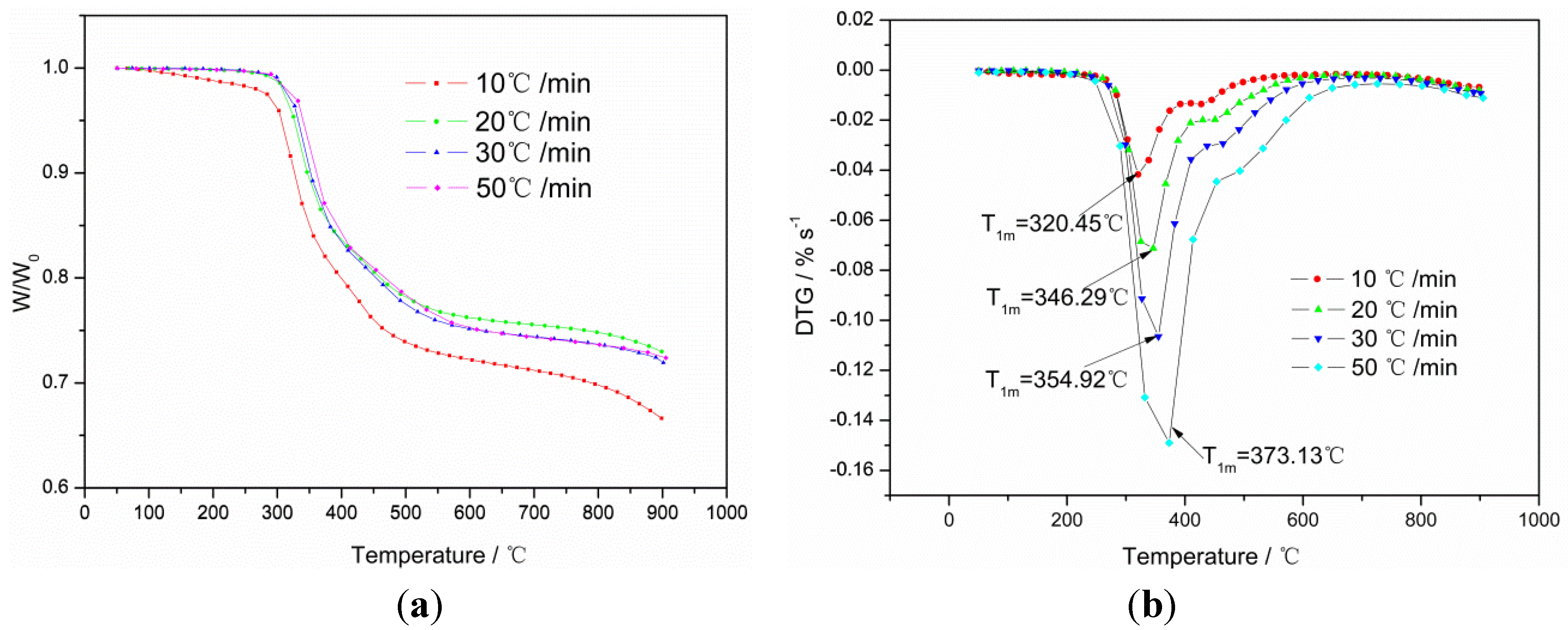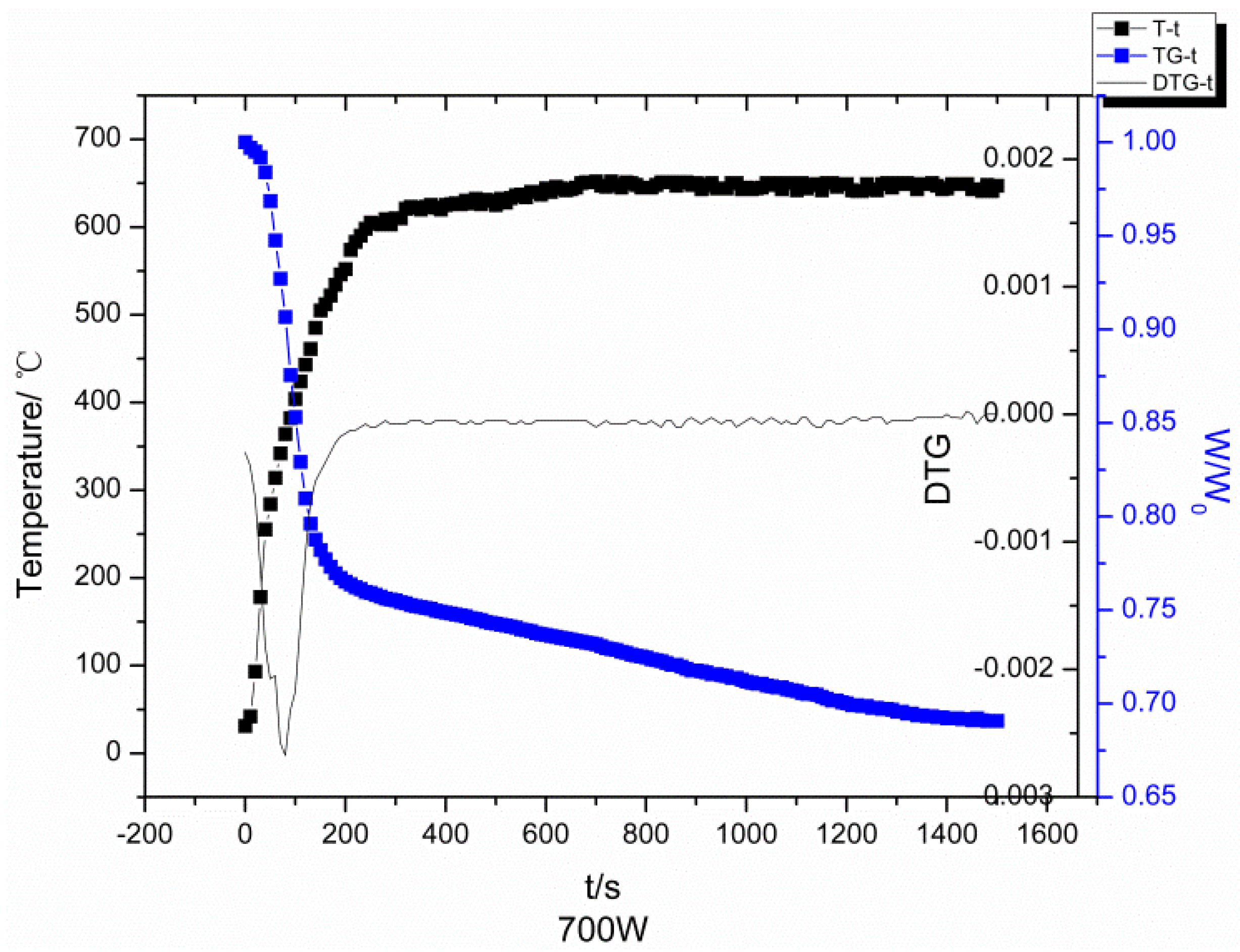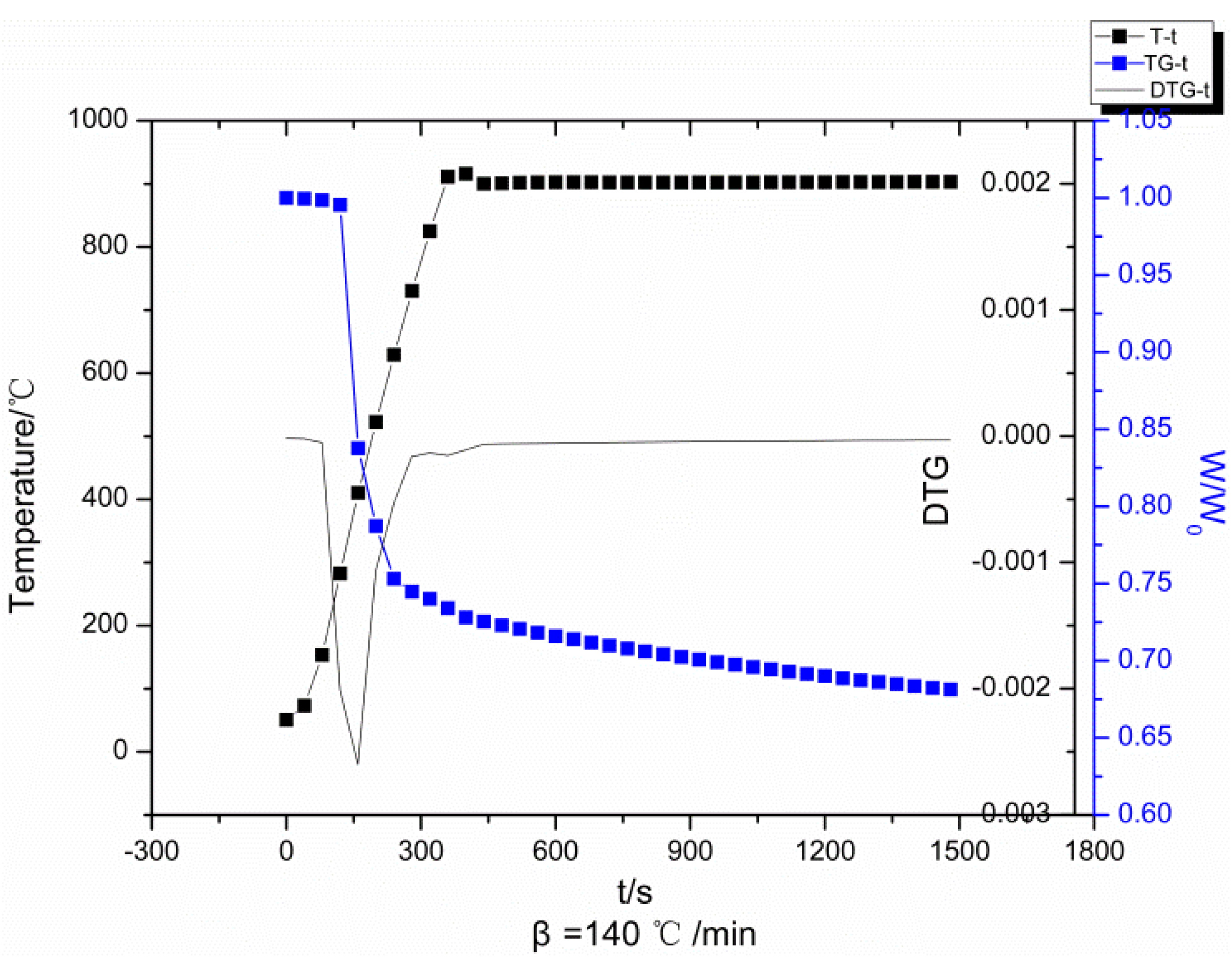Kinetic Study of the Pyrolysis of Waste Printed Circuit Boards Subject to Conventional and Microwave Heating
Abstract
:1. Introduction
2. Materials and Methods
2.1. Materials and Sample Preparation
2.2. Apparatus and Procedures

2.3. Pyrolysis Kinetics
3. Results and Discussion
3.1. Conventional Pyrolysis of WPCBs Using TGA

| °C/min) | n | E | lnA | R2 |
|---|---|---|---|---|
| 20 | 8.97 | 266.52 | 53.51 | 0.996 |
| 30 | 7.36 | 219.62 | 43.69 | 0.997 |
| 50 | 5.46 | 168.78 | 33.22 | 0.997 |
3.2. Microwave-induced Pyrolysis of WPCB


| Pyrolysis method | n | E | lnA | R2 |
|---|---|---|---|---|
| Microwave power | 2.41 | 48.68 | 9.50 | 0.992 |
| Simulated TGA | 6.90 | 106.20 | 22.10 | 0.990 |
4. Conclusions
Nomenclature
| A | Pre-exponential factor, s−1 |
| E | Activation energy, kJ/mol |
| f | Function of conversion |
| k | Thermal decomposition rate constant, s−1 |
| n | Reaction order |
| R | Gas constant = 8.314 kJ/(kmol K) |
| t | Pyrolysis time, s |
| T | Absolute temperature, K |
| T0 | The temperature at which the pyrolysis of WPCB begin, °C |
| T1m | The temperature at which the DTG curve of WPCB reaches the first peak, °C |
| T2m | The temperature at which the DTG curve of WPCB reaches the second peak, °C |
| W | Weight of sample at time t, mg and/or g |
| W0 | Initial weight of sample, mg and/or g |
| W∞ | Final weight of sample, mg and/or g |
| x | Conversion of WPCB, defined as: x = w0 − w/(w0 − w∞) |
| Greek letters | Descriptions |
| β | Heating rate, °C min−1 |
Acknowledgments
References
- Schwarzer, S; de Ono, A.; Peduzzi, P.; Giuliani, G.; Kluser, S. E-Waste, the Hidden Side of IT Equipment’s Manufacturing and Use. Environment Alert Bulletin; United Nations Environment Programme: Geneva, Switzerland, 2005. Available online: http://www.grid.unep.ch/products/3_Reports/ew_ewaste.en.pdf (accessed on 5 May 2005).
- Guo, J.; Guo, J.; Xu, Z. Recycling of non-metallic fractions from waste printed circuit boards: A review. J. Hazard. Mater. 2009, 168, 567–590. [Google Scholar] [CrossRef] [PubMed]
- Byers, T.J. Printed Circuit Board Design with Microcomputer; McGraw-Hill: New York, NY, USA, 1991. [Google Scholar]
- Das, A.; Vidyadhar, A.; Mehrotra, S.P. A novel flowsheet for the recovery of metal values from waste printedcircuit boards. Resour. Conserv. Recycl. 2009, 53, 464–469. [Google Scholar] [CrossRef]
- Hussain, Z.; Khan, K.M.; Hussain, K. Microwave-metal interaction pyrolysis of polystyrene. J. Anal. Appl. Pyrolysis 2010, 89, 39–43. [Google Scholar] [CrossRef]
- Ludlow-Palafox, C.; Chase, H.A. Microwave-induced pyrolysis of plastic wastes. Ind. Eng. Chem. Res. 2001, 40, 4749–4756. [Google Scholar] [CrossRef]
- Miura, M.; Kaga, H.; Sakurai, A.; Kakuchi, T.; Takahashi, K. Rapid pyrolysis of wood block by microwave heating. J. Anal. Appl. Pyrolysis 2004, 71, 187–199. [Google Scholar] [CrossRef]
- Huang, Y.F.; Kuan, W.H.; Lo, S.L.; Lin, C.F. Hydrogen-rich fuel gas from rice straw via microwave-induced pyrolysis. Bioresour. Technol. 2010, 101, 1968–1973. [Google Scholar] [CrossRef] [PubMed]
- Du, Z.; Li, Y.; Wang, X.; Wan, Y.; Chen, Q.; Wang, C.; Lin, X.; Chen, P.; Ruan, R. Microwave-assisted pyrolysis of microalgae for biofuel production. Bioresour. Technol. 2011, 102, 4890–4896. [Google Scholar] [CrossRef] [PubMed]
- Zhao, X.Q.; Song, Z.L.; Liu, H.Z.; Li, Z.Q.; Li, L.Z.; Ma, C.Y. Microwave pyrolysis of corn stalk bale: A promising method for direct utilization of large-sized biomass and syngas production. J. Anal. Appl. Pyrolysis 2010, 89, 87–94. [Google Scholar] [CrossRef]
- Zhao, X.Q.; Zhang, J.; Song, Z.L.; Liu, H.Z.; Li, L.Z.; Ma, C.Y. Microwave pyrolysis of straw bale and energy balance analysis. J. Anal. Appl. Pyrolysis 2011, 92, 43–49. [Google Scholar] [CrossRef]
- Domínguez, A.; Menéndez, J.A.; Fernández, Y.; Pis, J.J.; Valente, J.M.N.; Carrott, P.J.M.; Ribeiro Carrott, M.M.L. Conventional and microwave induced pyrolysis of coffee hulls for the production of a hydrogen rich fuel gas. J. Anal. Appl. Pyrolysis 2007, 79, 128–135. [Google Scholar] [CrossRef]
- Elharfia, K.; Mokhlisse, A.; Chanâa, M.B.; Outzourhit, A. Pyrolysis of the Moroccan (Tarfaya) oil shales under microwave irradiation. Fuel 2000, 79, 733–742. [Google Scholar] [CrossRef]
- Menéndez, J.A.; Domínguez, A.; Inguanzo, M.; Pis, J.J. Microwave-induced drying, pyrolysis and gasification (MWDPG) of sewage sludge: Vitrification of the solid residue. J. Anal. Appl. Pyrolysis 2005, 74, 406–412. [Google Scholar] [CrossRef]
- Menéndez, J.A.; Domínguez, A.; Inguanzo, M.; Pis, J.J. Microwave pyrolysis of sewage sludge: Analysis of the gas fraction. J. Anal. Appl. Pyrolysis 2004, 71, 657–667. [Google Scholar] [CrossRef]
- Lam, S.S.; Russell, A.D.; Lee, C.L.; Chase, H.A. Microwave-heated pyrolysis of waste automotive engine oil: Influence of operation parameters on the yield, composition, and fuel properties of pyrolysis oil. Fuel 2012, 92, 327–329. [Google Scholar] [CrossRef]
- Lam, S.S.; Russell, A.D.; Lee, C.L.; Lam, S.K.; Chase, H.A. Production of hydrogen and light hydrocarbons as a potential gaseous fuel from microwave-heated pyrolysis of waste automotive engine oil. Int. J. Hydrog. Energy 2012, 37, 5011–5021. [Google Scholar] [CrossRef]
- Lam, S.S.; Russell, A.D.; Chase, H.A. Microwave pyrolysis, a novel process for recycling waste automotive engine oil. Energy 2010, 35, 2985–2991. [Google Scholar] [CrossRef]
- Chen, K.S.; Yeh, R.Z.; Wu, C.H. Kinetics of thermal decomposition of epoxy resin in nitrogen-oxygen atmosphere. J. Environ. Eng. 1997, 123, 1041–1046. [Google Scholar] [CrossRef]
- Chen, K.S.; Chen, H.C.; Wu, C.H.; Chou., Y.M. Kinetics of thermal and oxidative decomposition of printed circuit boards. J. Environ. Eng. 1999, 125, 277–283. [Google Scholar] [CrossRef]
- Luda, M.P.; Balabanovich, A.I.; Zanetti, M.; Camino, G. Thermal decomposition of the retardant brominated epoxy resins. J. Anal. Appl. Pyrolysis 2002, 65, 25–40. [Google Scholar] [CrossRef]
- Barontini, F.; Marsanich, K.; Petarca, L.; Cozzani, V. Thermal degradation and decomposition products of electronic boards containing BFRs. Ind. Eng. Chem. Res. 2005, 44, 4186–4199. [Google Scholar] [CrossRef]
- Chien, Y.C.; Wang, H.P.; Lin, K.S.; Huang, Y.J.; Yang, Y.W. Fate of bromine in pyrolysis of printed circuit boardwastes. Chemosphere 2000, 40, 383–387. [Google Scholar] [CrossRef] [PubMed]
- Blazsó, M.; Czégény, Z.; Csoma, C. Pyrolysis and debromination of flame retarded polymers of electronic scrap studied by analytical pyrolysis. J. Anal. Appl. Pyrolysis 2002, 64, 249–261. [Google Scholar] [CrossRef]
- Menéndez, J.A.; Juárez-Pérez, E.J.; Ruisánchez, E.; Bermúdez, J.M.; Arenillas, A. Ball lightning plasma and plasma arc formation during the microwave heating of carbons. Carbon 2011, 49, 346–349. [Google Scholar] [CrossRef] [Green Version]
- Sun, J.; Wang, W.L.; Ma, C.Y.; Dong, Y. An exploratory study of electronic waste treatment: microwave-induced pyrolysis. In Proceedings of 2010 Asia–Pacific Power and Energy Engineering Conference, Chengdu, China, 28–31 March 2010; pp. 1–4.
- Sun, J.; Wang, W.L.; Liu, Z.; Ma, C.Y. Waste printed circuit boards reclamation by microwave-induced pyrolysis and featured mechanical processing. Ind. Eng. Chem. Res. 2011, 50, 11763–11769. [Google Scholar] [CrossRef]
- Wang, W.L.; Liu, Z.; Sun, J.; Ma, Q.L.; Ma, C.Y.; Zhang, Y.L. Experimental study on the heating effects of microwave discharge caused by metals. AIChE J. 2012. [Google Scholar] [CrossRef]
- Sun, J.; Wang, W.L.; Liu, Z.; Ma, C.Y. Study of the transference rules for bromine in waste printed circuit boards during microwave-induced pyrolysis. J. Air Waste Manag. Assoc. 2011, 61, 535–542. [Google Scholar] [CrossRef] [PubMed]
- Sun, J.; Wang, W.L.; Ma, C.Y.; Dong, Y. Study on pyrolysis characteristics of electronic waste. In Proceedings of the International Conference on Chemical, Biological and Environmental Engineering (CBEE 2009), Singapore, 9–11 October 2009; Kai, L., Ed.; World Scientific Publishing: Singapore, 2009; pp. 13–16. [Google Scholar]
- Chiang, H.L.; Lin, K.H.; Lai, M.-H.; Chen, T.C.; Ma, S.Y. Pyrolysis characteristics of integrated circuit boards at various particle sizes and temperatures. J. Hazard. Mater. 2007, 149, 151–159. [Google Scholar] [CrossRef]
- Narayan, R.; Antal, M.J., Jr. Thermal lag, fusion, and the compensation effect during biomass pyrolysis. Ind. Eng. Chem. Res. 1996, 35, 1711–1721. [Google Scholar] [CrossRef]
- Ceamanos, J.; Mastral, J.F.; Millera, A.; Aldea, M.E. Kinetics of pyrolysis of high density polyethylene: Comparison of isothermal and dynamic experiments. J. Anal. Appl. Pyrolysis 2002, 65, 93–110. [Google Scholar] [CrossRef]
© 2012 by the authors; licensee MDPI, Basel, Switzerland. This article is an open access article distributed under the terms and conditions of the Creative Commons Attribution license (http://creativecommons.org/licenses/by/3.0/).
Share and Cite
Sun, J.; Wang, W.; Liu, Z.; Ma, Q.; Zhao, C.; Ma, C. Kinetic Study of the Pyrolysis of Waste Printed Circuit Boards Subject to Conventional and Microwave Heating. Energies 2012, 5, 3295-3306. https://doi.org/10.3390/en5093295
Sun J, Wang W, Liu Z, Ma Q, Zhao C, Ma C. Kinetic Study of the Pyrolysis of Waste Printed Circuit Boards Subject to Conventional and Microwave Heating. Energies. 2012; 5(9):3295-3306. https://doi.org/10.3390/en5093295
Chicago/Turabian StyleSun, Jing, Wenlong Wang, Zhen Liu, Qingluan Ma, Chao Zhao, and Chunyuan Ma. 2012. "Kinetic Study of the Pyrolysis of Waste Printed Circuit Boards Subject to Conventional and Microwave Heating" Energies 5, no. 9: 3295-3306. https://doi.org/10.3390/en5093295




